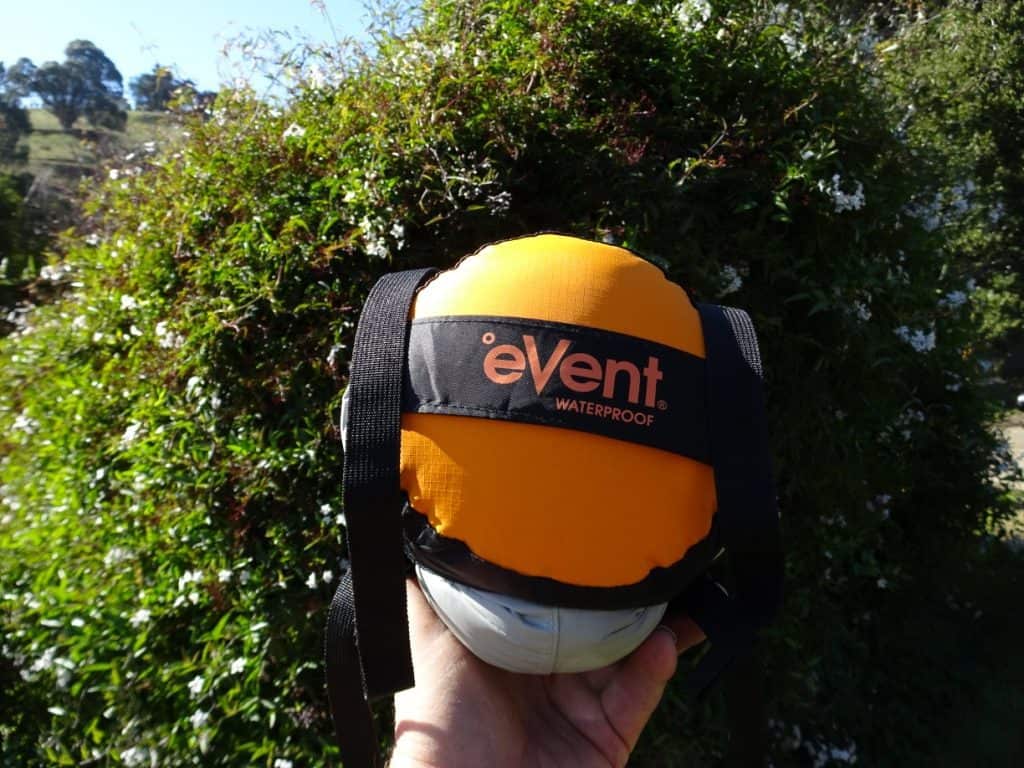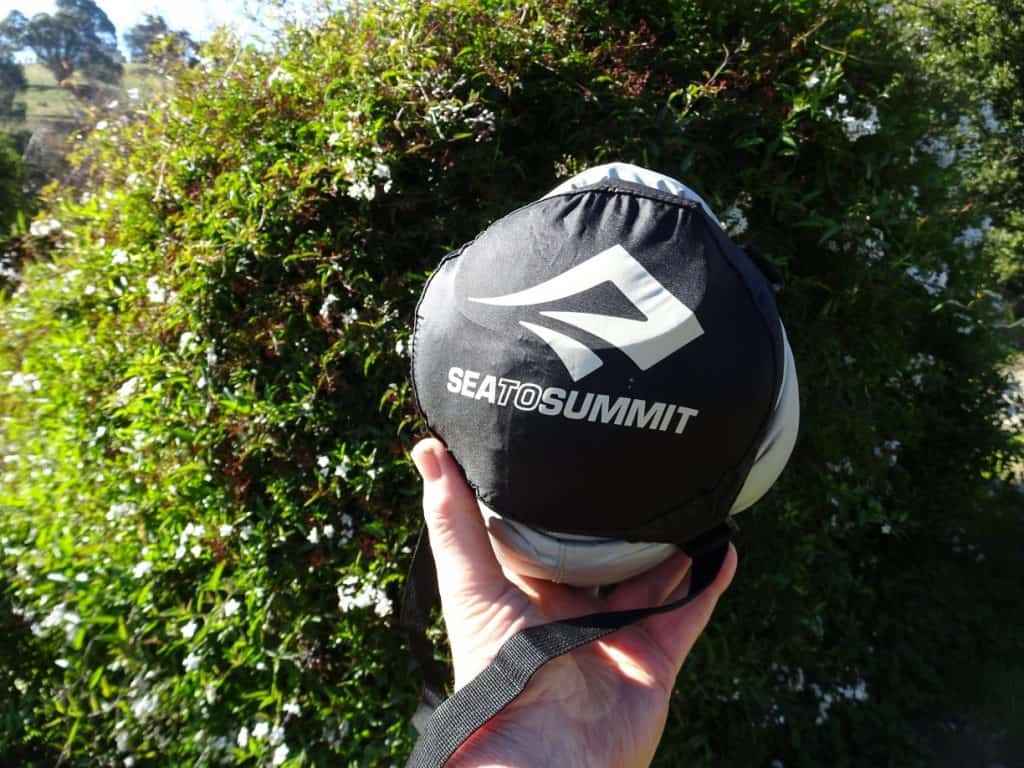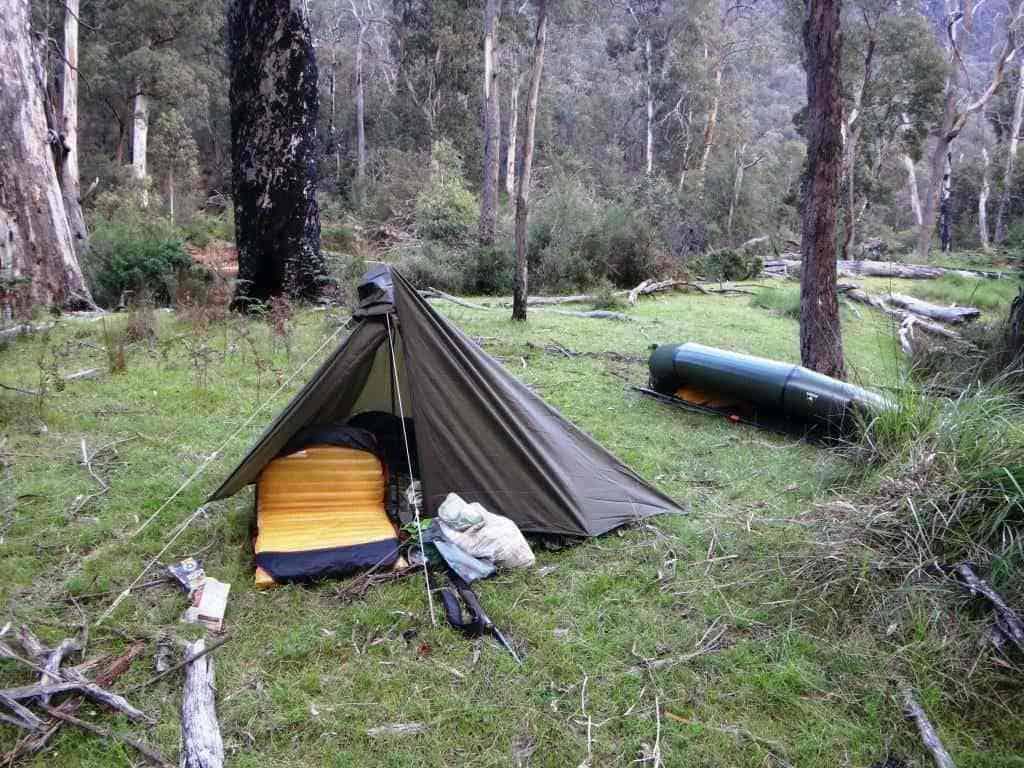I was asked this by a friend of mine who was planning his first overnight hunt (in winter) years ago in an area I often visit too. I have never needed a bag warmer than -1 to -3 C (and weighing just over half a kilo) even though I often sleep out in winter – indeed I prefer winter camping. The weather is usually drier and more stable, the night sky clear and brilliant with a billion stars, birdsong and the wild dingo’s call carry so much farther on the frosty air – and you can have a cheery toasty fire with perfect safety. Once you are away from vehicle tracks there is no shortage of firewood, so you can build your fire as large as you wish. You can always put a few more clothes on if it gets a bit colder, or get up and put another log on the fire!
In my hand is my trusty old -1C Montbell Ultralight Spiral Stretch #3 down bag compressed down to 2 litres in one of these: http://www.theultralighthiker.com/a-tardis-folding-space/


He bought the biggest warmest sleeping bag available. probably something like -15 or 20C and weighing several kilos – and he froze. He was so unhappy about it, he threw the bag, the tent and the back pack in his breakfast fire and never went winter camping again! He is like that: pig-headed. Some people have an aversion to learning from their mistakes.
I had told him also what mat I normally used – back then it was a Big Agnes Insulated Air Core which they claimed (correctly) was good for around 15F, so I had always been warm enough with it. Back then they only cost about US$50! And what did my friend take? You guessed it. A blue foamy! He had spent literally hundreds of dollars on the warmest sleeping bag he could find, and went away with a $5 mat which had practically no insulative quality at all!
Winters here in Victoria it rarely gets below about -10C, mostly not that cold. Of course high up is worse. The general rule is that temperature drops by .6-.8 of a degree Celsius for every 100 metre increase in elevation – and windier spots are worse of course – why you have a shelter of some sort, such as a tent really, rather than a bivy bag or swag. However, there is a ‘sweet spot’ neither at the bottom nor at the top which is the ‘ideal’ place to camp – provided there is water and a flat spot (unless you are hammock camping) where you get the warmest conditions of all. The cold from the top does flow down the hill and pool at the bottoms in the mornings, so you often have a frosty morn just before daybreak along the river bottoms.
The human body makes something like 150 watts of heat which is quickly dispersed unless it is covered by some kind of insulation. Insulation just slows this heat loss by a certain number of watts per square metre per unit of time. The higher the ‘R’ or ‘Clo’ rating the more that heat loss is slowed. Thinking only about the rating of your bag ignores where your body is losing heat. It is possible (even likely) that the ground is colder than the air and/or that conduction of heat may mean that you lose more heat to the ground to the air (radiation and convection). Further your body weight compresses the insulation in your bag and reduces its insulative ability so that it may approach zero where you are heaviest – and that is just where you will lose the most heat, and be coldest.
So, the most important thing to have is not the warmest bag, but the warmest mat! Obviously you are going to lose at least half your heat downwards, probably more. If you can substantially stop or slow this, you will not need such a warm bag or quilt. A brush or fern bed will help enormously at little cost or effort. Further, as you can wear some clothes to supplement the bag, clothes which you would need anyway, you can reduce the weight of the bag in this way.
I usually carry a down vest and coat, and of course wool longsleeve top and longjohns (in winter). I also own down trousers, though it would have to be very cold indeed for me to need them. However, as they only weigh around 200 grams they are a better (weight-wise) investment than the same (increased) weight of sleeping bag would be, particularly as clothes keep you warm too when you are not in bed. When it gets colder, I usually put on the down coat and slip my legs into the down vest. I also have a pair of down socks, which I heartily recommend. This strategy allows me to be comfortable down to probably -15C.
If I were to use a warmer mat than my normal Thermarest Neoair Xlite Womens, I would be comfy down to a much lower temperature, say -20C. That is one of the reasons why I am investigating the Thermarest X-Therm and some other cold weather pads – not to mention that I have a birthday coming up! With only half the heat loss, your bag will feel at least 5C warmer – and a warmer mat adds much less weight than a warmer bag or quilt. For example. a 5’6″ Womens weighs 340 grams (R=3.9) . An X-therm (R= 5.7) cut down to the same length will weigh 394 grams. Only 54 grams for probably a 10-15C increase in warmth! That 5.7 r-rating equates to comfort at around -24C or -20F. Warm enough for you? Another way to think about it is that if you are not losing heat to the ground you can ‘afford’ to lose twice as much heat to the air – and it is harder to lose heat to the air. Air is itself a good insulator. That is, if you have been cold outdoors (like my friend was), there’s a very good chance it was your mat’s fault, not your bag’s.
Of course it is also true that the insulation in the bottom of your bag doesn’t do much good (being compressed) so that you might be better off with a bag which has no insulation there at all (eg the Zpacks bag – but more in the top) or even a quilt – same principle. Some bags also have more insulation at the leg end on the theory that you can put a warm coat on the top half of your body.
In either case down is still warmer weight for weight than any synthetic insulation available. it pays to keep your sleeping bag dry anyway (eg by not breathing or sweating in it) as it will both become heavier and lose some of its insulative ability – though the myth that down has no insulation effect when wet is simply not true.
I encountered a girl on the Dusky Track in 2009 (when I pack rafted the Seaforth River) traveling with someone with the remarkable name ‘Caspar’ who simply could not be broken of the habit of having her head inside her sleeping bag and breathing in it to warm it up. During one afternoon and evening I loaned her all my warm clothes and sleeping bag whilst her partner tried to dry her bag out before a very measly fire at the Lake Roe Hut where there is just about zero firewood. I even let her use my coat and vest overnight, but she was still not convinced that she was causing the problem by breathing inside her bag. She was having a very miserable trip of it and I much doubt she has gone hiking often again.
PS: If you find your eg -1C bag is not quite warm enough, you can add some down to it, as we did in preparation for my Everest trip in 2016 where it can really easily get down to -20C.
PS2: Of course it also pays to keep your nose warm: http://www.theultralighthiker.com/are-you-beautiful-in-the-buff/
Just a reflection: My sleeping bag, mat and (poncho) tent (including groundsheet) take up about 3 litres of space in my pack and weigh less than a kilo altogether. I am almost without a doubt warmer, drier and more comfortable in them than someone with one of those giant canvas swags you see piled up on the back of every SUV ute heading ‘up the bush’ on weekends. Here I was set up on the upper Wonnangatta which I pack rafted back in November. (Plenty of firewood and no-one else there!)

Those guys with their swags usually have a ‘comfortable’ 2″ open cell mattress. How bad is that? What sort of R-rating do you suppose? Nowhere near the X-Lite Women’s even. Then, if it rains, that cold water (a much better conductor than air – as much as twenty times better), is stripping their body’s warmth away as quick as thought. A swag is just the most dreadful device and an awful encumbrance to boot. I made one once in my early years of hound hunting. After an awful cold night in a puddle on a mountaintop waiting for dogs, I went back to my K-Mart $20 dome tent. Much warmer, more spacious, drier and cheerier. But the set-up above (including the Cyclone Chair), is superior by far.
See Also:
http://www.theultralighthiker.com/womens-are-great-in-bed/
http://www.theultralighthiker.com/cold-season-pads/
http://www.theultralighthiker.com/i-followed-my-footsteps/
http://www.theultralighthiker.com/adding-down-to-a-sleeping-bag/
http://www.theultralighthiker.com/dusky-track-canoeing-the-seaforth/
http://www.theultralighthiker.com/new-zpacks-sleeping-bag/
http://www.theultralighthiker.com/montbell/
http://www.theultralighthiker.com/the-pocket-poncho-tent/
http://www.theultralighthiker.com/pack-rafting-the-remote-wonnangatta/
http://www.theultralighthiker.com/cyclone-chair/

